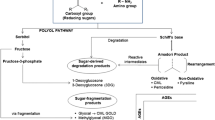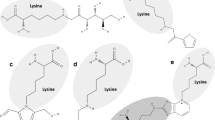Abstract
Advanced glycation end products (AGEs) are formed within the body as a part of normal metabolism and are also the by-products of cooking food. The elevated levels of AGEs in the body are considered pathogenic. The modern diets contain high levels of AGEs which are getting incorporated into the body AGEs pool and contribute to post-diabetic and age-related complications. The objective of the present study is to estimate the cross-linked AGEs (AGE-fluorescence) and the more stable carboxymethyl-lysine (CML) by spectrofluorimetry and ELISA in 58 kinds of foods in India. It was evident from the results that the foods cooked at higher temperatures showed high levels of AGEs. Among the studied foods, the highest fluorescence was observed in Biscuits 2 (362 AU), and the highest level of carboxymethyl lysine (CML) was found in Soya milk (659.3 ng/g). However, there was less correlation between the AGE-fluorescence and the CML content of the food samples. Processed food such as tomato sauce, chilli sauce, and cheese, along with western foods like chicken nuggets, pizza, and biscuits like Biscuits 2, are known to contain high levels of AGEs. In the present study a preliminary database of AGE-fluorescence and CML content of 58 foods was developed, which is the first attempt among Indian foods. Furthermore, elaborated database can be developed including maximum consumed foods in India which will help in suggesting a better diet for the diabetic population.





Similar content being viewed by others
Data Availability
No datasets were generated or analysed during the current study.
References
Stirban A, Gawlowski T, Roden M (2013) Vascular effects of advanced glycation endproducts: clinical effects and molecular mechanisms. Mol Metab 3:94–108. https://doi.org/10.1016/j.molmet.2013.11.006
Ahmed N (2005) Advanced glycation endproducts–role in pathology of diabetic complication. Diabetes Res Clin Pract 67:3–21. https://doi.org/10.1016/j.diabres.2004.09.004
Inan-Eroglu E, Ayaz A, Buyuktuncer Z (2020) Formation of advanced glycation endproducts in foods during cooking process and underlying mechanisms: a comprehensive review of experimental studies. Nutr Res Rev 33:77–89. https://doi.org/10.1017/S0954422419000209
Groener JB, Oikonomou D, Cheko R, Kender Z, Zemva J, Kihm L, Muckenthaler M, Peters V, Fleming T, Kopf S, Nawroth PP (2019) Methylglyoxal and Advanced Glycation End products in patients with diabetes - what we know so far and the missing links. Exp Clin Endocrinol Diabetes 127:497–504. https://doi.org/10.1055/s-0043-106443
Hegab Z, Gibbons S, Neyses L, Mamas MA (2012) Role of advanced glycation end products in cardiovascular disease. World J Cardiol 4:90–102. https://doi.org/10.4330/wjc.v4.i4.90
Singh VP, Bali A, Singh N, Jaggi AS (2014) Advanced glycation end products and diabetic complications. Korean J Physiol Pharmacol 18:1–14. https://doi.org/10.4196/kjpp.2014.18.1.1
Bohlender JM, Franke S, Stein G, Wolf G (2005) Advanced glycation end products and the kidney. Am J Physiol Ren Physiol 289:F645–F659. https://doi.org/10.1152/ajprenal.00398.2004
Kandarakis SA, Piperi C, Topouzis F, Papavassiliou AG (2014) Emerging role of advanced glycation-end products (AGEs) in the pathobiology of eye diseases. Prog Retin Eye Res 42:85–102. https://doi.org/10.1016/j.preteyeres.2014.05.002
Tamanna N, Mahmood N (2015) Food Processing and Maillard reaction products: effect on human health and nutrition. Int J Food Sci 2015:26752. https://doi.org/10.1155/2015/526762
Yacoub R, Nugent M, Cai W, Nadkarni GN, Chaves LD, Abyad S, Honan AM, Thomas SA, Zheng W, Valiyaparambil SA, Bryniarski MA, Sun Y, Buck M, Genco RJ, Quigg RJ, He JC, Uribarri J (2017) Advanced glycation end products dietary restriction effects on bacterial gut microbiota in peritoneal dialysis patients; a randomized open label controlled trial. PLoS ONE 12. https://doi.org/10.1371/journal.pone.0184789
Sun X, Tang J, Wang J, Rasco BA, Lai K, Huang Y (2015) Formation of advanced glycation endproducts in ground beef under pasteurisation conditions. Food Chem 172:802–807. https://doi.org/10.1016/j.foodchem.2014.09.129
Henle T, Miyata T (2003) Advanced glycation end products in uremia. Adv Ren Replace ther 10:321–331. https://doi.org/10.1053/j.arrt.2003.08.006
Uribarri J, Cai W, Peppa M, Goodman S, Ferrucci L, Striker G, Vlassara H (2007) Circulating glycotoxins and dietary advanced glycation endproducts: two links to inflammatory response, oxidative stress, and aging. Gerontol Biol Sci Med Sci 62:427–433. https://doi.org/10.1093/gerona/62.4.427
Cai W, Gao QD, Zhu L, Peppa M, He C, Vlassara H (2002) Oxidative stress-inducing carbonyl compounds from common foods: novel mediators of cellular dysfunction. Mol Med 8:337–346
Zhu Y, Snooks H, Sang S (2018) Complexity of advanced glycation end products in foods: where are we now? J Agric Food Chem 66:1325–1329. https://doi.org/10.1021/acs.jafc.7b05955
Goldberg T, Cai W, Peppa M, Dardaine V, Baliga BS, Uribarri J, Vlassara H (2004) Advanced glycoxidation end products in commonly consumed foods. J Am Diet Assoc 104:1287–1291. https://doi.org/10.1016/j.jada.2004.05.214
Uribarri J, Woodruff S, Goodman S, Cai W, Chen X, Pyzik R, Yong A, Striker GE, Vlassara H (2010) Advanced glycation end products in foods and a practical guide to their reduction in the diet. J Am Diet Assoc 110:911–16e12. https://doi.org/10.1016/j.jada.2010.03.018
Luevano-Contreras C, Chapman-Novakofski K (2010) Dietary advanced glycation end products and aging. Nutrients 2:1247–1265. https://doi.org/10.3390/nu2121247
Assar SH, Moloney C, Lima M, Magee R, Ames JM (2009) Determination of nepsilon-(carboxymethyl)lysine in food systems by ultra performance liquid chromatography-mass spectrometry. Amino Acids 36:317–326. https://doi.org/10.1007/s00726-008-0071-4
Xu R, Yue L, Kang S, Liu L (2016) Assessment of the concentration of advanced glycation end products in traditional Chinese foods. J Food Process Preserv 41:1–9. https://doi.org/10.1111/jfpp.12811
Nowotny K, Schröter D, Schreiner M, Grune T (2018) Dietary advanced glycation end products and their relevance for human health. Ageing Res Rev 47:55–66. https://doi.org/10.1016/j.arr.2018.06.005
Clarke RE, Dordevic AL, Tan SM, Ryan L, Coughlan MT (2016) Dietary advanced glycation end products and risk factors for chronic disease: a systematic review of Randomised controlled trials. Nutrients 8:125. https://doi.org/10.3390/nu8030125
Semba RD, Ang A, Talegawkar S, Crasto C, Dalal M, Jardack P, Traber MG, Ferrucci L, Arab L (2012) Dietary intake associated with serum versus urinary carboxymethyl-lysine, a major advanced glycation end product, in adults: the energetics study. Eur J Clin Nutr 66:3–9. https://doi.org/10.1038/ejcn.2011.139
Mark AB, Poulsen MW, Andersen S, Andersen JM, Bak MJ, Ritz C, Holst JJ, Nielsen J, de Courten B, Dragsted LO, Bügel SG (2014) Consumption of a diet low in advanced glycation end products for 4 weeks improves insulin sensitivity in overweight women. Diabetes Care 37:88–95. https://doi.org/10.2337/dc13-084
Takeuchi M, Takino J, Furuno S, Shirai H, Kawakami M, Muramatsu M, Kobayashi Y, Yamagishi S (2015) Assessment of the concentrations of various advanced glycation end-products in beverages and foods that are commonly consumed in Japan. PLoS ONE 10:e0118652. https://doi.org/10.1371/journal.pone.0118652
Renzone G, Arena S, Scaloni A (2015) Proteomic characterization of intermediate and advanced glycation end-products in commercial milk samples. J Proteom 117:12–23. https://doi.org/10.1016/j.jprot.2014.12.021
Chen G, Smith JS (2015) Determination of advanced glycation endproducts in cooked meat products. Food Chem 168:190–195. https://doi.org/10.1016/j.foodchem.2014.06.081
Zhang G, Huang G, Xiao L, Mitchell AE (2011) Determination of advanced glycation endproducts by LC-MS/MS in raw and roasted almonds (Prunus dulcis). J Agric Food Chem 59:12037–12046. https://doi.org/10.1021/jf202515k
Acknowledgements
We thank ICMR for providing ICMR- a centenary post-doctoral fellowship for the present study and the Director ICMR-NIN for her constant support in conducting this study.
Funding
This research is supported by Indian Council of Medical Research.
Author information
Authors and Affiliations
Contributions
Alekhya Gottumukkala: Conceptualization, Methodology, executing the experiment, writing the original draft. Devindra Shekappa: Conceptualization, guidance, and editing of the manuscript.
Corresponding author
Ethics declarations
Competing Interests
The authors declare no competing interests.
Declarations Ethical Approval and Consent to Participate
Not applicable.
Consent for Publication
Alekhya Gottumukkala: Written informed consent for publication was obtained from Dr. Gottumukkala Alekhya, who contributed to Conceptualization, Methodology, experiment executing and, writing the original draft. Devindra Shekappa: Written informed consent for publication was obtained from Dr. Devindra Shekappa, who contributed to Conceptualization, provided guidance and editing the manuscript.
Conflict of Interest
The authors declare no conflict of interest.
Additional information
Publisher’s Note
Springer Nature remains neutral with regard to jurisdictional claims in published maps and institutional affiliations.
Electronic Supplementary Material
Below is the link to the electronic supplementary material.
Rights and permissions
Springer Nature or its licensor (e.g. a society or other partner) holds exclusive rights to this article under a publishing agreement with the author(s) or other rightsholder(s); author self-archiving of the accepted manuscript version of this article is solely governed by the terms of such publishing agreement and applicable law.
About this article
Cite this article
Gottumukkala, A., Shakappa, D. Estimation of Advanced Glycation End Products in Selected Foods and Beverages by Spectrofluorimetry and ELISA. Plant Foods Hum Nutr (2024). https://doi.org/10.1007/s11130-024-01173-y
Accepted:
Published:
DOI: https://doi.org/10.1007/s11130-024-01173-y




